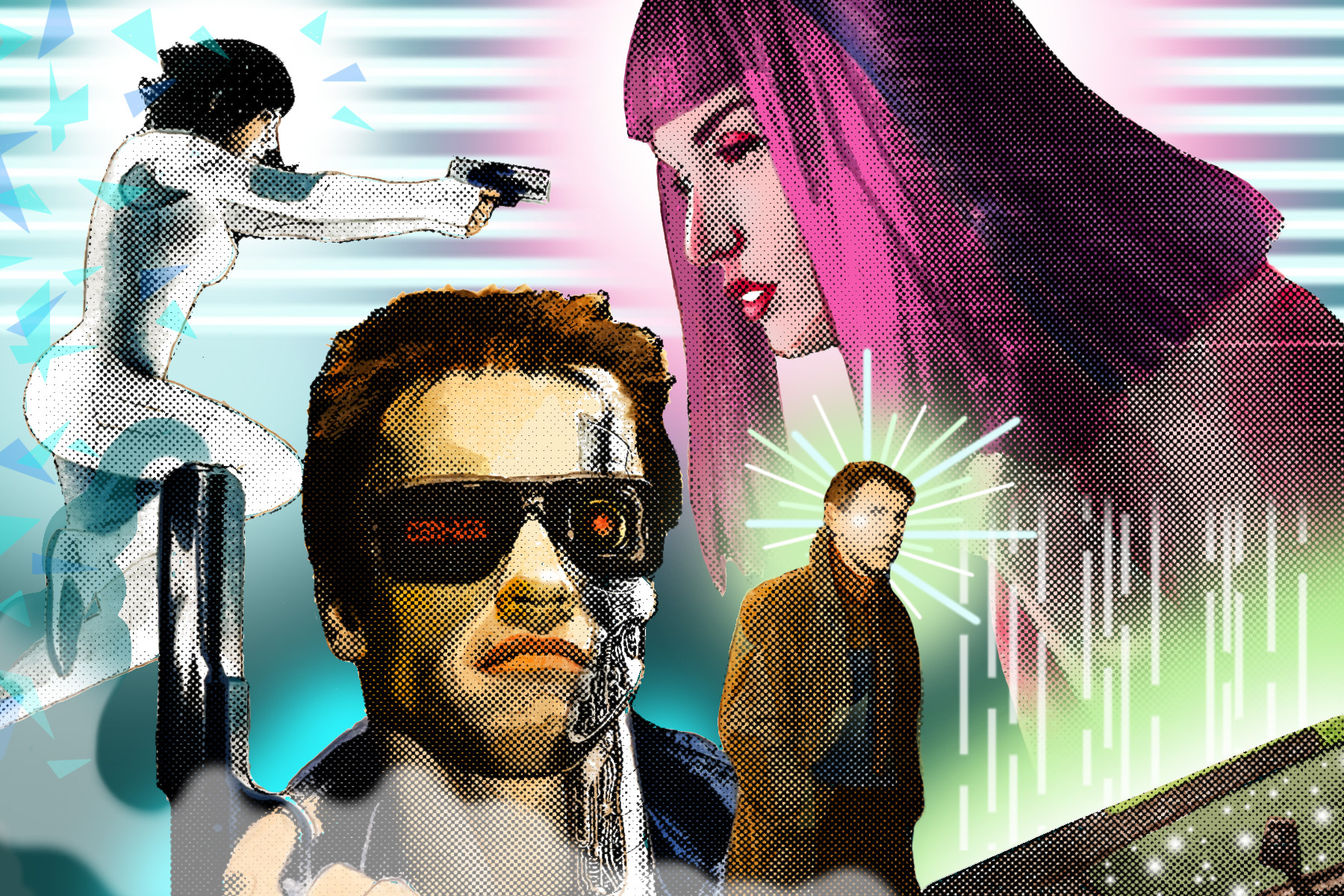The film noir genre emerged in the United States during the 1940s and 1950s as a response to the disillusionment and cynicism many Americans felt following World War II. Characterized by its dark and brooding themes, fatalism and low-key lighting, film noir depicted bleak and corrupt societies where the line between right and wrong was blurred, and the protagonists were flawed and morally ambiguous. Science fiction, on the other hand, is a genre that explores speculative and futuristic concepts, often depicting advanced technological innovations and their impact on society.
Although these two genres may seem totally different from each other, film noir has had a profound impact on science fiction. This hybrid genre, known as “tech noir,” first appeared in the 1980s as neo-noir (post-1950s films with noir themes) films with elements of science fiction. As cyberpunk and other types of science fiction became more popular, the genre grew into what we know today.
One major influence of film noir on science fiction is the use of themes of darkness and corruption. Both genres explore the darker aspects of society, but film noir emphasizes the moral ambiguity of its characters and the consequences of their actions; for example, in 1944’s “Double Indemnity,” the protagonist Walter Neff is an insurance salesman who becomes embroiled in a plot to murder a wealthy man and collect the insurance money. As the story unfolds, Walter finds himself caught in a web of deceit, betrayal and murder, and he struggles to extricate himself from the situation. This sense of fatalism and the struggle of the individual against a larger, faceless system is a recurring theme in both genres. Tech noir and its sister cyberpunk often portray dystopian societies where individuals face similar struggles against oppressive governments or technological advances that threaten their way of life. In the 1984 classic “The Terminator,” an ordinary woman named Sarah Connor is on the run from a cyborg assassin sent back in time to kill her after it is discovered that her unborn son would one day save mankind from Skynet, a hostile artificial intelligence in post-apocalyptic 2029.
Another significant influence of film noir on science fiction is the visual style and techniques used in film noir cinematography. The use of low-key lighting, chiaroscuro (strong contrasts between light and dark) and tilted camera angles all contribute to the dark and brooding atmosphere of film noir. These same techniques have been used in many tech noir films to create a sense of suspense and unease, as well as to emphasize the darker aspects of the story. In the seminal 1982 film “Blade Runner,” the use of rain-soaked, neon-lit streets, high-contrast lighting and heavy smoke and fog add to the noir aesthetic. Director Ridley Scott stated that the constant heavy rain in Los Angeles, a city known for its dry climate, was added to hide the wires used to operate the Spinners, the flying cars used by the LAPD. Additionally, the camera angles and framing techniques used in the film are reminiscent of film noir, with close-ups and Dutch angles used to create a sense of unease and tension. These visual elements contribute to the film’s dystopian, post-industrial world where moral ambiguity and existential angst reign supreme, making “Blade Runner” a standout example of film noir-inspired cinematography in science fiction.
Film noir’s influence on science fiction extends beyond worldbuilding and visuals. It is also evident in characterization. The morally ambiguous and flawed characters that are prevalent in film noir have become popular in science fiction, where the heroes are not always perfect, and their flaws and moral struggles make them more relatable and compelling. In many modern sci-fi films, the protagonists face difficult choices that require them to make sacrifices and question their own morality.
The Wachowski Sisters’ cyberpunk magnum opus “The Matrix” (1999) employs these noir tropes to great effect. In the film, the protagonist Neo, portrayed by Keanu Reeves, discovers that his entire life has been a computer-generated simulation controlled by intelligent machines that have enslaved humanity. He is given a choice: He can accept the truth and join a rebellion against the machines, or he can return to the simulated world he has always known. As Neo learns more about the rebellion and the true nature of reality, he realizes that his decisions have real consequences, and he must make sacrifices for what he believes in. Additionally, Neo must question his own morality as he faces the difficult choice of whether to sacrifice the lives of his fellow rebels to save his own. The film’s exploration of identity, free will and moral choice make it a classic example of science fiction that forces its protagonist to confront difficult choices and grapple with complex moral dilemmas.
Since it first appeared in American cinemas in the 1940s, film noir and its influences have been ever-present forces in popular culture. The genre has had a particularly profound impact on cyberpunk, shaping its themes, motifs, and visual style. Both genres tend to explore the darker aspects of society, and their protagonists often struggle against corrupt systems and institutions. Film noir often portrays a world in which individual morality is pitted against societal norms, and tech-noir and cyberpunk expand on this by exploring the impact of technology and alien life forms on the individual and society. Film noir’s influence has shaped the themes, style and storytelling techniques of some of the most beloved sci-fi works, and it continues to inspire filmmakers and writers today.















